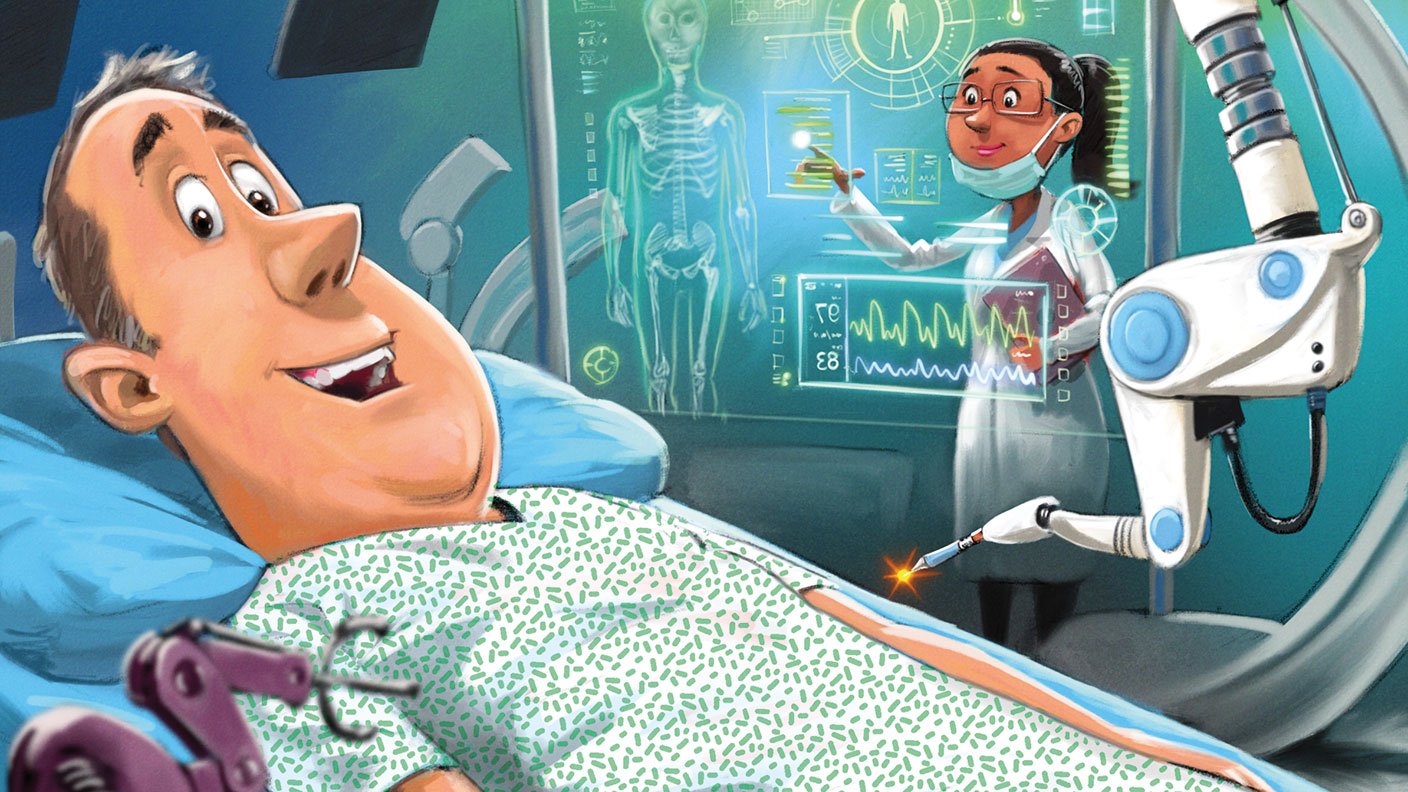Healthy profits: how to make money from investing in medical technology
There’s far more to the health sector than whizzy new pills, says Dr. Mike Tubbs. He reviews the latest developments in areas ranging from robotic surgery to joint replacements and suggests some top stocks.


When it comes to health, drug research tends to hog the limelight – especially in the middle of a pandemic. But there’s a great deal more to the overall health sector than the pharmaceutical or biotechnology companies that concentrate solely on new pills. There are five major subsectors: radiotherapy, diagnostics (detecting and monitoring disease), body-part replacements (from artificial joints to heart pacemakers), robotic surgery and advanced wound care.
The UK is well represented in health. Companies range from the FTSE 100’s medical technology giant Smith & Nephew, a specialist in advanced wound care, orthopaedics and joint replacements, to Aim-listed Advanced Medical Solutions, which mostly serves the wound care and surgical markets. We examine a range of global health companies and suggest some of the better ones as potential investments.
The broad healthcare sector is defensive – it tends to be resilient to economic downturns – since people continue to need healthcare during recessions. However, the pandemic has shown that, under pressure, some healthcare companies are more defensive than others. This is because drug treatments for chronic diseases must continue, whereas joint replacements, for example, are elective and likely to be delayed when hospitals are under pressure from Covid-19 patients. This explains the differing share-price performances of healthcare companies from mid-February to the end of March. The FTSE 100 fell by 23% but Gilead Sciences (a large biotech) rose by 11%, whereas Smith & Nephew (hip and knee replacements) slipped by 21%.
MoneyWeek
Subscribe to MoneyWeek today and get your first six magazine issues absolutely FREE

Sign up to Money Morning
Don't miss the latest investment and personal finances news, market analysis, plus money-saving tips with our free twice-daily newsletter
Don't miss the latest investment and personal finances news, market analysis, plus money-saving tips with our free twice-daily newsletter
Taking on tumours
Radiotherapy treats cancers with radioactivity, often using X-rays. As chemoradiotherapy, it is combined with chemotherapy (chemical drug therapy designed to destroy rapidly-growing cells) to treat most solid tumours. Radiotherapy equipment is almost a duopoly with two firms, Varian Medical Systems and Elekta, together accounting for up to 80% of the global market for systems (both equipment and related software). Varian is strongest in the US, Elekta stronger in Europe.
The two companies’ latest product developments are very different: Varian has introduced a compact proton-therapy system (protons are sometimes used instead of X-rays in radiotherapy) costing around $30m. In 2019 Elekta introduced a magnetic resonance imaging (MRI)-guided radiotherapy system called Unity, priced at $6m. The key selling point is that a clearer image of the tumour makes it easier to alter the dose of radiation based on daily changes to the tumour’s shape or size. Unity is selling well, with 75 orders received by June 2020. Elekta provides its comprehensive oncology software systems to smaller proton therapy companies in collaborative deals.
A picture of health
Diagnostics and body-condition monitoring includes imaging techniques such as MRI, ultrasound and PET (positron emission tomography, using radioactivity to measure metabolic processes); other key areas are blood tests and the monitoring equipment in intensive-care units. The largest diagnostics company in the world is Swiss drug giant Roche, but its diagnostics division comprises just 21% of total sales, so an investment in Roche is primarily in pharmaceuticals.
Companies involved in diagnostics include Philips Healthcare, Abbott Laboratories, Danaher and Thermo Fisher Scientific, together with Illumina, the world leader in gene sequencing. Philips is one of three firms in high-end imaging, which accounts for 44% of its sales, with the balance from patient-monitoring and related care (24%) and personal products (shavers, beauty, oral health and so on).
Abbott’s sales stem mainly from medical devices (38.4%) and diagnostics (24.2%). Danaher has 36.8% of sales in diagnostics, 38.7% in life-science research equipment, with the remainder in environmental fields (water quality, for instance). Thermo Fisher has 15% of sales from diagnostics, 22% from analytical instruments, 27% from specialised life-science analysis and the remainder from other laboratory products.
Rebuilding the body
Replacement body parts range from passive, inert parts – such as knee and hip joints, stents and heart valves – to active electronic inserts, such as heart pacemakers. The major orthopaedic-device manufacturers (makers of hip, knee, shoulder and other joints) include market leader Johnson & Johnson (J&J), through its DePuy Synthes subsidiary, Stryker, Zimmer Biomet and Smith & Nephew.
Medtronic is the world’s largest non-pharmaceutical healthcare company and markets a wide range of these products, including a pacemaker allowing users to have MRI scans safely (hitherto rarely possible). It has 38% of sales from cardiac and vascular therapies, 28% from minimally invasive therapies (surgical, respiratory, renal), 27% from restorative therapies (spine, brain) and the remainder from diabetes control. Abbott has 38.4% of its sales from medical devices, with 24.2% from diagnostics, 23.2% from nutritionals and the balance from generic drugs.
The surgeon’s little helper
Robot-assisted surgery is a fast-growing area dominated by America’s Intuitive Surgical. Intuitive has installed over 5,500 Da Vinci robotic-surgery systems in hospitals worldwide and more doctors have been trained in the use of its technologies than any other. The Da Vinci system is used for highly efficient laparoscopic (keyhole) operations, which leave much smaller scars and enable more rapid recovery than is possible with conventional open surgery.
Advanced wound care also covers a wide range of products, from surgical incision closures to materials designed to fight infection and promote rapid healing of wounds. Major companies in the US, the world’s largest market for wound care, include Ethicon (part of Johnson & Johnson), Acelity, Medtronic and Cardinal Health. In the UK important firms in this context are Smith & Nephew, ConvaTec and Advanced Medical Solutions; Denmark has Coloplast.
Rapid innovators rising to the occasion
Before discussing the investment potential of healthcare companies, it is worth examining how some, mostly those that dabble in pharmaceuticals, have risen to the challenge of the coronavirus. The responses of some health companies demonstrate an impressive ability to innovate and bring new products to market quickly if required.
Consider Johnson & Johnson (J&J), which has been working on Covid-19 vaccines since January and announced in late March that it had selected a lead vaccine candidate; clinical trials will start by, or before, September. J&J is working with the US government in a $1bn co-funded programme and expects to have its first vaccines ready by early 2021. The company will produce over one billion doses of the vaccine on a not-for-profit basis. But J&J is competing with several other companies and groups that are well advanced.
Roche and Abbott have both had antibody tests (which reveal if someone has had the virus and is probably immune) approved by the NHS. Abbott is ramping up production to 20 million doses in June and beyond. Abbott has also produced two different antigen tests for Covid-19 (tests that tell if a patient has the virus). The first is for laboratory environments. Several million of these were produced in April.
The second, approved under the Food and Drug Administration’s emergency-use authorisation procedure is portable (toaster-sized) for use in doctors’ surgeries and care facilities. This will give a positive result in five minutes and a negative one in 13 minutes. Abbott ramped up production to produce 50,000 per day from 14 April. Medtronic, meanwhile, has publicly shared the design specifications for its proprietary ventilator to reinforce the global effort to make more ventilators for intensive-care units.
Lastly, AstraZeneca, GlaxoSmithKline and the University of Cambridge have formed a joint collaboration on Covid-19 testing and on the use of alternative reagents for existing tests to overcome current bottlenecks. They have been joined by diagnostics firm Novacyt, contracted to supply the NHS with 288,000 Covid-19 tests per week for six months from late April. Its shares rose from 14p in early 2020 to 335p at the end of May. Novacyt’s test was the second (after Roche’s) to be listed by the World Health Organisation.
Narrowing down the field
In selecting companies as potential investments we look for four main characteristics. The first is a leading global (or at least regional) position in its subsector, preferably market leader or number two. The second is a record of profitable growth, while the third is net cash or modest debt; this has become even more important now that the pandemic has emphasised the vulnerability of companies carrying high debt. The fourth is a record of innovation bolstered by a substantial investment in research and development for new products.
There are two general options for investment. The first is to select a large, diversified healthcare company with leading positions in several subsectors. Medtronic and J&J are typical examples of this approach. The second is via firms specialising in one subsector and with a leading global position in it. Typical examples of this approach are Illumina, which specialises in gene sequencing, where it is world leader; Intuitive Surgical for robotic surgery, or Elekta, the world number two in radiotherapy. Within the first option there are two types of firm: those covering more than one subsector within healthcare and those spanning both health and another sector that may be unrelated to health.
Investment options
In this section we select one or two excellent companies from each of the five subsectors mentioned earlier and include both diversified companies and some operating in only one subsector. All those selected have enduring advantages that protect their businesses from competitors, or “wide moats”.
J&J probably has the widest moat, with market leadership in orthopaedics, in several drug markets, a major position in advanced wound care and a successful consumer-products arm. This diversity is a source of strength. Medtronic is the world’s largest pure-play medical devices company, is diversified over several chronic disease areas and has a strong record of innovation, with new products protected by intellectual property (IP). Its moat depends both on IP and on its close relationships with physicians. They are loyal to the group as they have used its products for successful operations on many patients.
In diagnostics, Danaher is a strong competitor, with 37% of sales from diagnostic equipment, one of the highest percentages for the companies discussed above. Its other major business is in equipment for life-sciences research. Both divisions have strong recurring sales (84% for diagnostics in 2019). Abbott has around one quarter of its sales from diagnostics, with another 38.4% from medical devices, so it is another option along with Danaher and Medtronic.
In radiotherapy, Varian and Elekta are strongest in different world regions (Varian in the US, Elekta in Europe) and are prioritising different routes with their latest new products, so an investment in radiotherapy could be split between them. Illumina in genomic sequencing and Intuitive Surgical in robot-assisted surgery are both global leaders in their subsectors, with wide moats.
Two smaller British companies worth mentioning are Victrex and Advanced Medical Solutions. Victrex is the global leader in applications of PEEK, an advanced polymer material with a wide range of uses, including medical. Around nine million implanted devices worldwide (primarily in joints) contain PEEK. Invibio, Victrex’s medical division, accounts for only 20% of revenue, but has a higher gross profit margin (83% compared with 54% for the industrial division). Victrex has a record of high profitability and had net cash of £42m at end March.
Advanced Medical Solutions (AMS) is similarly expanding its IP-protected branded products, which are mainly in the surgical rather than wound-care divisions, are higher-margin and currently make up 55% of revenue. Its two recent acquisitions are both in the surgical division. AMS had net cash of £65m at the end of its last financial year (December 2019). For those who prefer an investment trust to a selection of individual stocks, the Worldwide Healthcare Trust is a possibility.
However, in common with most healthcare-orientated trusts, it mainly invests in pharmaceuticals and biotechnology, which make up around two-thirds of the portfolio. Health equipment, services and life-science tools make up the other third.
The stocks to consider now
We now examine the investment potential of ten health-sector companies highlighted above, along with the Worldwide Healthcare Trust. It is instructive to look at each one’s debt level, share-price performance as the markets fell, valuation and dividend yield. On debt levels there are three groups of companies. J&J, Varian and Elekta have low debt levels, Medtronic and Abbott have quite high but manageable levels and have been paying debt down, but Danaher has a high debt to EBITDA ratio following its acquisition of GE Healthcare and is therefore eliminated. Illumina, Intuitive, Victrex and AMS have net cash.
Health is seen as a defensive sector so the shares of major healthcare companies should fall less than the market in times of recession. The pandemic caused markets to fall sharply, so this gives us an up-to-date experiment revealing the degree of defensiveness of various health-sector stocks . The FTSE All Share index fell by 24.9% between mid-February and the end of March. Varian and Elekta fell most (-30% & -29%), followed by Medtronic (-23.1%), Intuitive (-17.9%) and Victrex (-14.8%). The lowest falls were shown by J&J (-12%), Abbott (-12%), AMS (-9.7%) and Illumina (-8.6%). Worldwide Healthcare fell by -11%, putting it in centre of the latter group.
The price/earnings ratios (p/e) of Intuitive (46.6) and Illumina (48) are highest. Both are growing fast, but Intuitive’s price is further above fair value. Next is Abbott (26.5), then Varian (23.6), Victrex (21.8), Elekta (20.3), Medtronic (16.9) and J&J (15.9). There is no analyst 2021 p/e for AMS, but I estimate 23.
Based on the combination of net cash or reasonable debt, defensive characteristics and valuation, we select all but Intuitive. Dividend yields of these companies are Victrex (LSE: VCT, 2.9%), J&J (NYSE: JNJ, 2.6%), Medtronic (NYSE: MDT, 2.3%), Elekta (Stockholm: EKTA-B, 2.1%), Abbott Laboratories (NYSE: ABT,1.5%), Advanced Medical Solutions (Aim: AMS, 0.65%), but no dividend yet for Illumina (Nasdaq: ILMN) or Varian (NYSE: VAR). Elekta is the least defensive, but does have a reasonable yield. Worldwide Healthcare Trust (LSE: WWH) has a yield of 0.7%.
Dr Mike Tubbs writes on investment, business and technological innovation and has worked in multinationals as head of R&D and in business consultancy and investment management (michael.tubbs@innovatubbs.plus.com)
Get the latest financial news, insights and expert analysis from our award-winning MoneyWeek team, to help you understand what really matters when it comes to your finances.
Highly qualified (BSc PhD CPhys FInstP MIoD) expert in R&D management, business improvement and investment analysis, Dr Mike Tubbs worked for decades on the 'inside' of corporate giants such as Xerox, Battelle and Lucas. Working in the research and development departments, he learnt what became the key to his investing; knowledge which gave him a unique perspective on the stock markets.
Dr Tubbs went on to create the R&D Scorecard which was presented annually to the Department of Trade & Industry and the European Commission. It was a guide for European businesses on how to improve prospects using correctly applied research and development.
He has been a contributor to MoneyWeek for many years, with a particular focus on R&D-driven growth companies.
-
 ‘Why I have ditched my Help to Buy ISA for cash savings and the stock market’
‘Why I have ditched my Help to Buy ISA for cash savings and the stock market’Without the 25% bonus, my Help to Buy ISA is effectively redundant, says MoneyWeek writer Sam Walker.
-
 Is your inheritance tax allowance cut if you sell to downsize or sell your home to pay for care?
Is your inheritance tax allowance cut if you sell to downsize or sell your home to pay for care?Downsizing relief is a little-known benefit that could save your loved ones tens of thousands of pounds in inheritance tax after you’ve died.
-
 Stock markets have a mountain to climb: opt for resilience, growth and value
Stock markets have a mountain to climb: opt for resilience, growth and valueOpinion Julian Wheeler, partner and US equity specialist, Shard Capital, highlights three US stocks where he would put his money
-
 The steady rise of stablecoins
The steady rise of stablecoinsInnovations in cryptocurrency have created stablecoins, a new form of money. Trump is an enthusiastic supporter, but its benefits are not yet clear
-
 SRT Marine Systems: A leader in marine technology
SRT Marine Systems: A leader in marine technologySRT Marine Systems is thriving and has a bulging order book, says Dr Michael Tubbs
-
 Goodwin: A superlative British manufacturer to buy now
Goodwin: A superlative British manufacturer to buy nowVeteran engineering group Goodwin has created a new profit engine. But following its tremendous run, can investors still afford the shares?
-
 A change in leadership: Is US stock market exceptionalism over?
A change in leadership: Is US stock market exceptionalism over?US stocks trailed the rest of the world in 2025. Is this a sign that a long-overdue shift is underway?
-
 A reckoning is coming for unnecessary investment trusts
A reckoning is coming for unnecessary investment trustsInvestment trusts that don’t use their structural advantages will find it increasingly hard to survive, says Rupert Hargreaves
-
 Metals and AI power emerging markets
Metals and AI power emerging marketsThis year’s big emerging market winners have tended to offer exposure to one of 2025’s two winning trends – AI-focused tech and the global metals rally
-
 8 of the best houses for sale with beautiful fireplaces
8 of the best houses for sale with beautiful fireplacesThe best houses for sale with beautiful fireplaces – from a 15th-century cottage in Kent to a 17th-century palazzo in Oxfordshire
